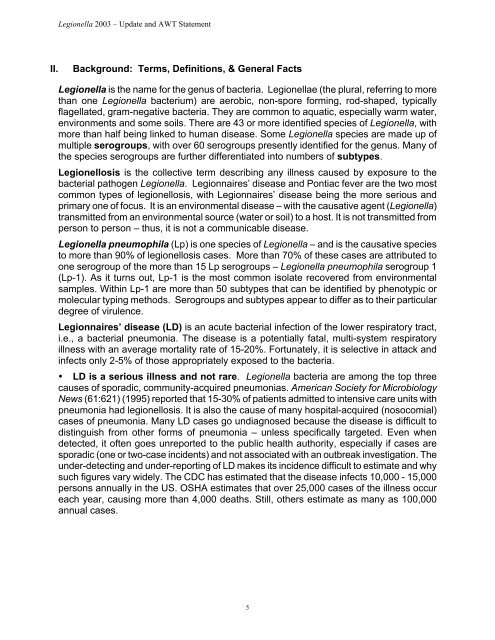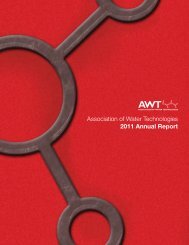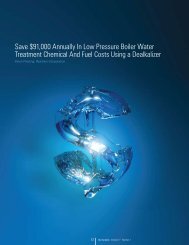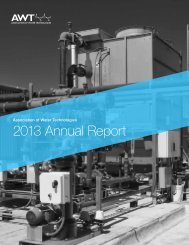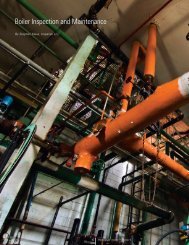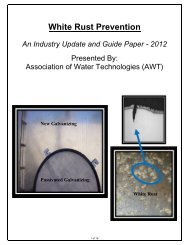Legionella: An Update and Statement by AWT - Association of Water ...
Legionella: An Update and Statement by AWT - Association of Water ...
Legionella: An Update and Statement by AWT - Association of Water ...
Create successful ePaper yourself
Turn your PDF publications into a flip-book with our unique Google optimized e-Paper software.
<strong>Legionella</strong> 2003 – <strong>Update</strong> <strong>and</strong> <strong>AWT</strong> <strong>Statement</strong><br />
II.<br />
Background: Terms, Definitions, & General Facts<br />
<strong>Legionella</strong> is the name for the genus <strong>of</strong> bacteria. <strong>Legionella</strong>e (the plural, referring to more<br />
than one <strong>Legionella</strong> bacterium) are aerobic, non-spore forming, rod-shaped, typically<br />
flagellated, gram-negative bacteria. They are common to aquatic, especially warm water,<br />
environments <strong>and</strong> some soils. There are 43 or more identified species <strong>of</strong> <strong>Legionella</strong>, with<br />
more than half being linked to human disease. Some <strong>Legionella</strong> species are made up <strong>of</strong><br />
multiple serogroups, with over 60 serogroups presently identified for the genus. Many <strong>of</strong><br />
the species serogroups are further differentiated into numbers <strong>of</strong> subtypes.<br />
Legionellosis is the collective term describing any illness caused <strong>by</strong> exposure to the<br />
bacterial pathogen <strong>Legionella</strong>. Legionnaires’ disease <strong>and</strong> Pontiac fever are the two most<br />
common types <strong>of</strong> legionellosis, with Legionnaires’ disease being the more serious <strong>and</strong><br />
primary one <strong>of</strong> focus. It is an environmental disease – with the causative agent (<strong>Legionella</strong>)<br />
transmitted from an environmental source (water or soil) to a host. It is not transmitted from<br />
person to person – thus, it is not a communicable disease.<br />
<strong>Legionella</strong> pneumophila (Lp) is one species <strong>of</strong> <strong>Legionella</strong> – <strong>and</strong> is the causative species<br />
to more than 90% <strong>of</strong> legionellosis cases. More than 70% <strong>of</strong> these cases are attributed to<br />
one serogroup <strong>of</strong> the more than 15 Lp serogroups – <strong>Legionella</strong> pneumophila serogroup 1<br />
(Lp-1). As it turns out, Lp-1 is the most common isolate recovered from environmental<br />
samples. Within Lp-1 are more than 50 subtypes that can be identified <strong>by</strong> phenotypic or<br />
molecular typing methods. Serogroups <strong>and</strong> subtypes appear to differ as to their particular<br />
degree <strong>of</strong> virulence.<br />
Legionnaires’ disease (LD) is an acute bacterial infection <strong>of</strong> the lower respiratory tract,<br />
i.e., a bacterial pneumonia. The disease is a potentially fatal, multi-system respiratory<br />
illness with an average mortality rate <strong>of</strong> 15-20%. Fortunately, it is selective in attack <strong>and</strong><br />
infects only 2-5% <strong>of</strong> those appropriately exposed to the bacteria.<br />
• LD is a serious illness <strong>and</strong> not rare. <strong>Legionella</strong> bacteria are among the top three<br />
causes <strong>of</strong> sporadic, community-acquired pneumonias. American Society for Microbiology<br />
News (61:621) (1995) reported that 15-30% <strong>of</strong> patients admitted to intensive care units with<br />
pneumonia had legionellosis. It is also the cause <strong>of</strong> many hospital-acquired (nosocomial)<br />
cases <strong>of</strong> pneumonia. Many LD cases go undiagnosed because the disease is difficult to<br />
distinguish from other forms <strong>of</strong> pneumonia – unless specifically targeted. Even when<br />
detected, it <strong>of</strong>ten goes unreported to the public health authority, especially if cases are<br />
sporadic (one or two-case incidents) <strong>and</strong> not associated with an outbreak investigation. The<br />
under-detecting <strong>and</strong> under-reporting <strong>of</strong> LD makes its incidence difficult to estimate <strong>and</strong> why<br />
such figures vary widely. The CDC has estimated that the disease infects 10,000 - 15,000<br />
persons annually in the US. OSHA estimates that over 25,000 cases <strong>of</strong> the illness occur<br />
each year, causing more than 4,000 deaths. Still, others estimate as many as 100,000<br />
annual cases.<br />
5


